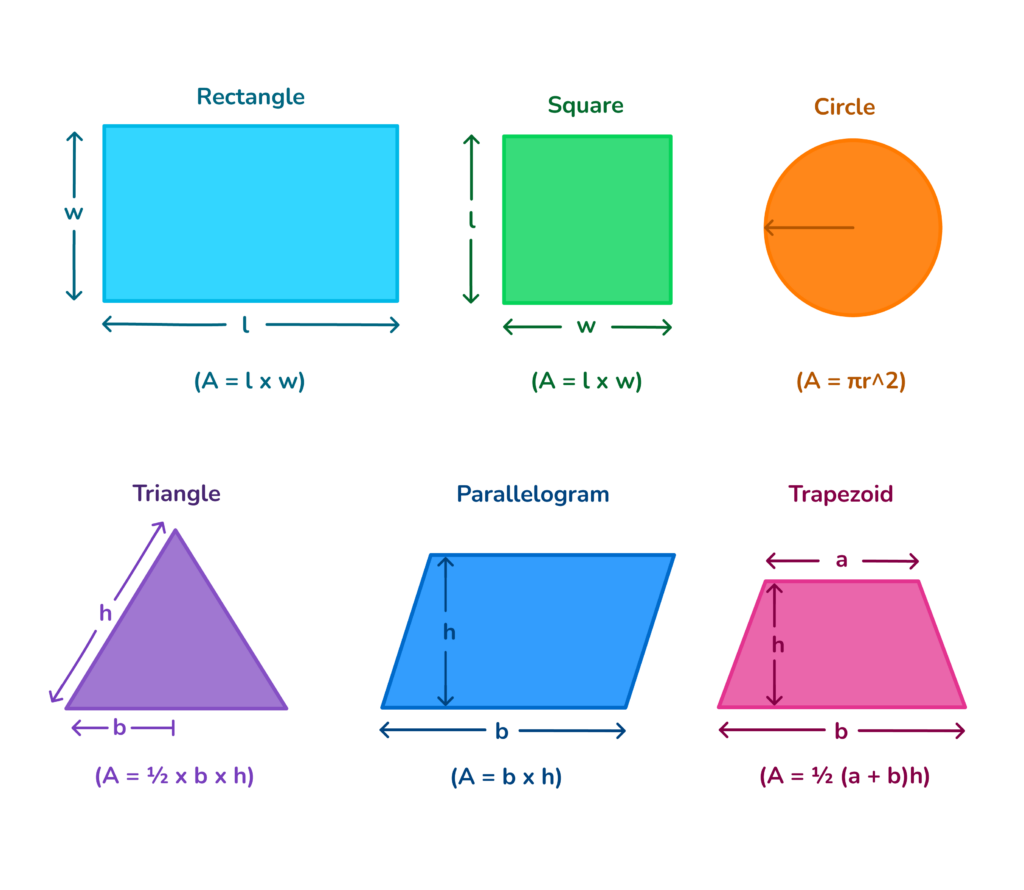What is Area in Math?
Area in math: A measure of the space inside a shape. Learn the area formula for various shapes and real-world applications.

Author
Michelle Griczika
Published:
Oct 2024
Key takeaways
- • Area is how we measure the space inside of a shape. Finding the area helps us understand the size of a bedroom or football field.
- • Different shapes have different area formulas.
- • There are many examples of calculating area in everyday life, like buying the right amount of paint or setting up a garden.
The concept of area in math is more than just numbers and shapes; it’s about real-life applications. Picture this – choosing the right amount of paint for a wall or a room’s carpet size. That’s where area steps in. This simple yet essential math concept helps us navigate the world, making the abstract tangible.
Definition of area in math
What is area? Area in math is about counting squares. When we define area, it means how many square units fit inside a shape or figure. If you picture a square 3O units long on each side, the area is 9 square units. This is because 9 squares, each 1 unit by 1 unit, can fit inside. The concept of area math works the same way for all shapes, not just squares. From circles to triangles and more complex figures, the idea is to calculate how many square units fill up that shape. This area definition math principle helps us understand and describe the space around us.
Real-life examples of calculating area
Think about a farmer with a rectangular field. The length of his field is 200 feet, and the width is 100 feet. The farmer needs to know the total space of his field to buy the correct amount of seeds. He multiplies the length by the width and finds out his field is 20,000 square feet.
In a different scenario, consider an architect who is designing a room. She has a perfect square room, with each side being 12 feet. She calculates the area to ensure the furniture will fit and leave enough space to move around. By multiplying the length and the width, she determines the room is 144 square feet. From farming to house design, the concept of area is essential.
Table of contents
Get more practice with area and math with DreamBox!
Practice learning area more with DreamBox Math
DREAMBOX MATH
Get started for FREE today!

What is the formula for area?
The formula to calculate area depends on the shape in question. For basic shapes such as a square or a rectangle, the area is the product of the length and the width. However, their area formula becomes more complicated as the shapes become complex. Let’s take a look at a variety of area formulas by shape:
- Square or Rectangle: In a square or rectangle, the formula for area is simply length times width (A = l x w). This basic formula is one of the most used in area calculation. If you have a square room that measures 10 feet on each side, the area of the room would be 10 feet (length) times 10 feet (width), which equals 100 square feet. For a rectangular space, you use the length and width of the rectangle similarly.
- Circle: The formula to calculate the area of a circle is pi times the radius squared (A = πr^2). Here, the radius is the distance from the circle’s center to its edge, and pi is a mathematical constant approximately equal to 3.14159.
- Triangle: For a triangle, the area formula is one-half the base times the height (A = ½ x b x h). This formula is used when you know the base and the height of the triangle.
- Parallelogram: The area of a parallelogram is calculated by multiplying the base by the height (A = b x h).
- Trapezoid: When dealing with a trapezoid, the area formula is the average of the lengths of the bases (the parallel sides) times the height (A = ½ (a + b)h)).

Here’s a quick table of all the area formulas for reference:
| Shape | Area Formula |
| Square/Rectangle | A = l x w |
| Circle | A = πr^2 |
| Triangle | A = ½ (b x h) |
| Parallelogram | A = b x h |
| Trapezoid | A = ½ (a + b)h |

The math program that drives results
Get started today!
DreamBox adapts to your child’s level and learning needs, ensuring they are appropriately challenged and get confidence-building wins.
Area vs perimeter
How to measure area relates to the surface covered by a shape, while the perimeter speaks to the total boundary length around that shape. Both play crucial roles in geometry, but they’re distinct. Think of a football field. The entire space where the game is played that’s the area. Now consider the distance you’d travel if you ran around the edge of the field. That’s the perimeter.
Area vs volume
Volume measures the quantity of three-dimensional space an object inhabits. It’s like filling a box with small cubes and calculating how many fit inside. This measure considers not just the surface, as area does, but the entirety of the space within the object’s boundaries. So while area and volume are related, they offer distinct ways to understand and interact with space. If you think of area as the carpet on your living room floor, volume would be the space your living room occupies, from floor to ceiling.
Practice Problems
Click on the boxes below to see the answers!
The area of the rectangle is 40 square units.
The area of the circle is approximately 113.04 square units.
The area of the triangle is 6 square units.
The area of the trapezoid is 49 square units.
The area of the square is 100 square units.
The area of the rectangle is 105 square units.
The area of the circle is approximately 78.5 square units.
The area of the triangle is 24 square units.
The area of the trapezoid is 54 square units.
The area of the square is 144 square units.
Area in Math Practice Problems
Q.1
What is the area of a rectangle with a length of 10 units and a width of 5 units?
Quiz Complete!
You got 0 out of 5 questions correct.
FAQs about area in math
The formula varies depending on the shape. For rectangles and squares, A = length x width. The area of a circle is A = 𝜋r^2. Finally, the area of a triangle is A = ½ (base x height).
The area is calculated to determine the size of a surface or a two-dimensional space. This is crucial in real-world situations, like buying sufficient paint for a room or determining the number of tiles required to cover a floor.
A practical example of area is when you need to paint a wall. You’d calculate the area of the wall to know how much paint you’ll need.
Area is just the inside space of a shape, counted in squares. Perimeter is the distance around the outside of the shape, counted in a straight line.
Take at home math practice to the next level
Empowering parents and educators to make math practice more impactful. Plus, your kids will love it.


